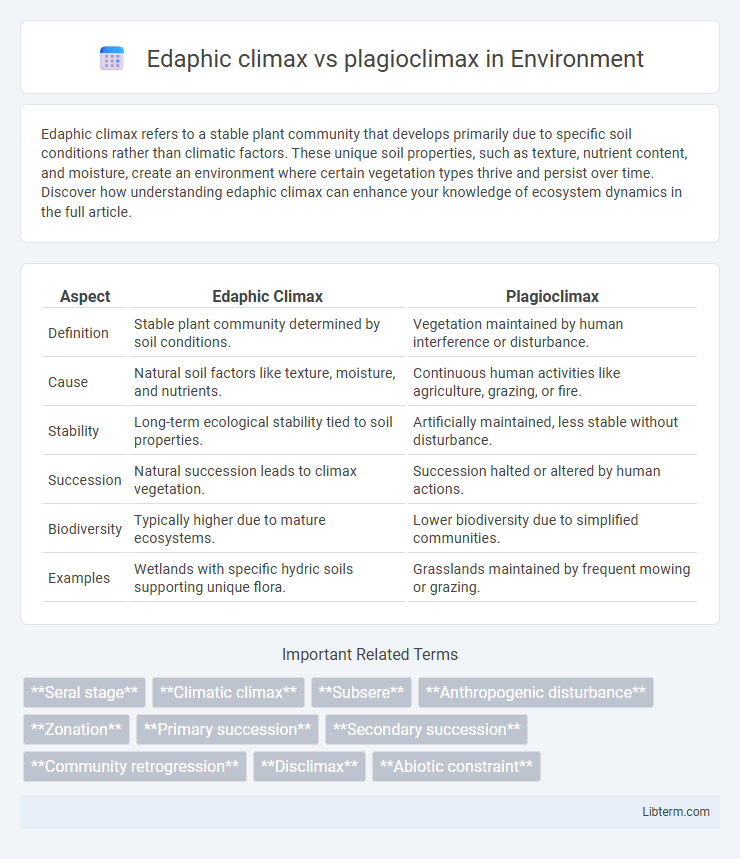Edaphic climax refers to a stable plant community that develops primarily due to specific soil conditions rather than climatic factors. These unique soil properties, such as texture, nutrient content, and moisture, create an environment where certain vegetation types thrive and persist over time. Discover how understanding edaphic climax can enhance your knowledge of ecosystem dynamics in the full article.
Table of Comparison
| Aspect | Edaphic Climax | Plagioclimax |
|---|---|---|
| Definition | Stable plant community determined by soil conditions. | Vegetation maintained by human interference or disturbance. |
| Cause | Natural soil factors like texture, moisture, and nutrients. | Continuous human activities like agriculture, grazing, or fire. |
| Stability | Long-term ecological stability tied to soil properties. | Artificially maintained, less stable without disturbance. |
| Succession | Natural succession leads to climax vegetation. | Succession halted or altered by human actions. |
| Biodiversity | Typically higher due to mature ecosystems. | Lower biodiversity due to simplified communities. |
| Examples | Wetlands with specific hydric soils supporting unique flora. | Grasslands maintained by frequent mowing or grazing. |
Introduction to Ecological Climax Concepts
Edaphic climax refers to a stable ecological community established on specific soil conditions that prevent succession from progressing to the climaxes typical of the regional climate. Plagioclimax describes a seral stage maintained by human activities or disturbances, hindering the natural progression toward the potential climax community. These concepts are fundamental in understanding how soil properties and anthropogenic factors influence the stability and development of ecosystems.
Defining Edaphic Climax and Its Characteristics
Edaphic climax refers to a stable ecological community that develops due to specific soil conditions rather than climatic factors, resulting in unique vegetation adapted to those soil properties. This climax is characterized by plant species composition strongly influenced by soil texture, pH, moisture, and nutrient availability, which create microhabitats distinct from surrounding ecosystems. Unlike plagioclimax, which arises from human disturbance or management preventing natural succession, edaphic climax represents a naturally stable state dictated by edaphic factors.
Understanding Plagioclimax Ecosystems
Plagioclimax ecosystems are stabilized communities resulting from human interference that halts natural succession, unlike edaphic climax ecosystems determined primarily by soil conditions. These ecosystems maintain a semi-permanent vegetation state due to activities like agriculture, grazing, or controlled burning, preventing progression to the potential natural climax community. Understanding plagioclimax dynamics is crucial for ecological restoration and land management, as it highlights how anthropogenic factors shape vegetation patterns and biodiversity.
Key Differences Between Edaphic Climax and Plagioclimax
Edaphic climax refers to a stable plant community established due to specific soil conditions that limit ecological succession, whereas plagioclimax is a community altered or maintained by human activities such as farming or grazing. Edaphic climax depends primarily on inherent soil properties like texture, drainage, and nutrient availability, while plagioclimax results from external disturbances preventing natural succession. The key difference lies in the natural soil-driven stability of edaphic climax versus the human-induced interruption characteristic of plagioclimax ecosystems.
Role of Soil Factors in Edaphic Climax Formation
Soil factors such as texture, pH, moisture retention, and nutrient availability play a crucial role in the formation of an edaphic climax, where plant communities stabilize based on specific soil conditions rather than climatic influences. Unlike plagioclimax, which arises from human disturbances preventing natural succession, edaphic climax vegetation reflects a stable ecosystem shaped primarily by the inherent soil properties. These distinct soil characteristics create microenvironments that support specialized flora adapted to persist over long periods, defining the edaphic climax community.
Human Influence Leading to Plagioclimax
Human activities such as agriculture, urbanization, and deforestation disrupt natural ecological succession, resulting in a plagioclimax where the vegetation remains in a arrested or altered state rather than reaching the stable edaphic climax. Soil compaction, pollution, and continuous land use modify soil properties, preventing the establishment of climax species and encouraging pioneer or secondary species dominance. These anthropogenic factors create persistent ecological communities that differ from the natural edaphic climax determined by soil conditions and long-term environmental stability.
Examples of Edaphic Climax Communities
Edaphic climax communities develop in response to unique soil conditions rather than climatic factors, such as the serpentine soils of California supporting specialized vegetation like Jeffrey pine and certain chaparral species. Another example includes the sand dune ecosystems along coastal regions where nutrient-poor, sandy soils sustain pioneer plants like beach grass that dominate these edaphic climax communities. These communities differ from plagioclimax by being stable and self-sustaining despite the restrictive soil characteristics.
Common Plagioclimax Landscapes and Their Origins
Common plagioclimax landscapes include heathlands, grasslands, and scrublands, often resulting from human activities such as grazing, burning, or cultivation that prevent natural succession. These disturbances maintain vegetation in a stable but arrested state, differing from edaphic clxi resulting from soil conditions that naturally restrict progression to later ecological stages. Plagioclimax sites illustrate the interaction between anthropogenic influences and environmental factors shaping ecosystem structure and biodiversity.
Ecological Implications of Climax Disruption
Edaphic climax occurs when soil conditions stabilize a unique plant community, whereas plagioclimax results from human disturbances altering natural succession. Disruption of these climaxes leads to reduced biodiversity, soil degradation, and altered nutrient cycling that can impair ecosystem resilience. Understanding these ecological implications aids in restoration efforts and sustainable land management practices.
Conservation and Management Strategies for Climax Communities
Edaphic climax communities develop on unique soil conditions that limit succession, requiring conservation efforts focused on soil preservation and preventing anthropogenic alterations. Plagioclimax communities arise from human disturbances halting natural succession, necessitating management strategies such as controlled burning, selective planting, and invasive species control to restore or maintain ecological balance. Effective conservation of both involves habitat restoration, monitoring soil health, and implementing adaptive management practices to support biodiversity and ecosystem stability.
Edaphic climax Infographic

 libterm.com
libterm.com